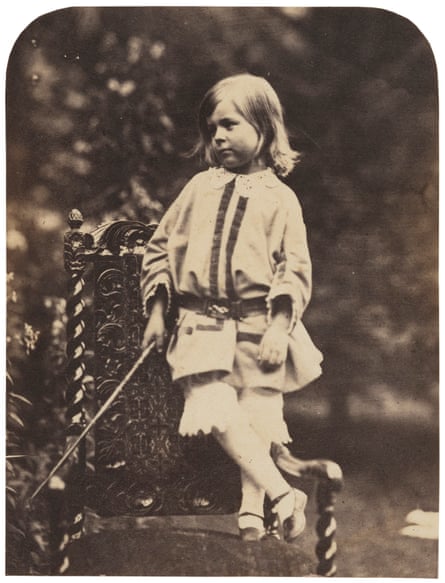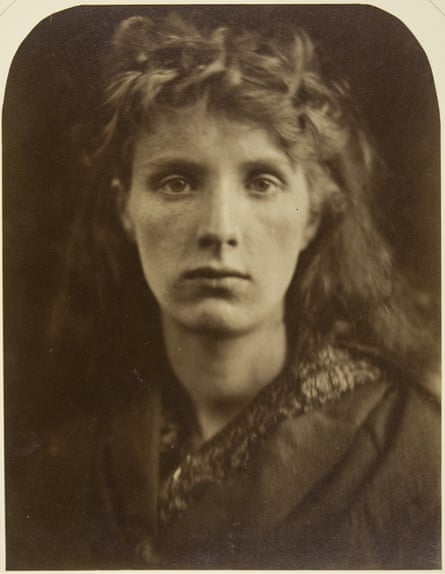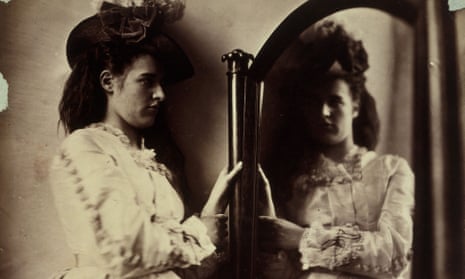Two young women stand side by side in the bright light of a window. One looks dreamily into the light, the other stares back at us, arms folded. She is confrontational, challenging. It is a bold, modern image. Are they suffragettes or is this a photo from the age of punk?
Neither. This portrait of Isabella Grace and Clementina Maude was taken by their mother, Clementina, Lady Hawarden, in 1863-4. Photography as a way of recording permanent images was only about 25 years old, even if experiments with cameras had been going on longer. The invention of the wet-plate collodion process by Frederick Scott Archer in 1851 revolutionised the young medium. Its use of glass negatives coated in silver nitrate made sharp, lucid, bright images such as Hawarden’s photograph of Grace and Maude possible. The results are uncanny. Time and again in this captivating exhibition you find yourself looking at people so precisely captured by the collodion process they seem to be alive, among us, now.
Here is Charles Darwin, portrayed by Julia Margaret Cameron in 1868, nearly a decade after the publication of On the Origin of Species made him notorious. The Darwin family had rented Cameron’s house on the Isle of Wight for a holiday, and she took the chance to fix his image for posterity. Like her other prints, this is big and expansive, with a subtle rich focus that makes Darwin seem to be preserved in silvery liquid. You can see the light in his eyes, as the dark pupils rise under his heavy brow in what looks like a moment of wonder and introspection. While he keeps still for the Victorian camera’s slow exposure, he is thinking. Pondering, perhaps, the evolution of human beings that he was to map out in his next book.

And those are his real eyes, with real light dancing in them – not an artist’s impression, not a painterly flourish. From the moment of photography’s birth, the question of its relationship with traditional “art” hung in shafts of light as they reacted with chemicals to record images. The 1840s pioneer Henry Fox Talbot called this new way of making pictures “the pencil of nature” – for it seemed that nature could now leave its own artistic impression.
The thesis of this exhibition is that by the 1860s, a group of British photographers who all used the sensual wet-plate collodion method saw themselves as artists and sought to show the true aesthetic power of the new medium. It argues, pretty convincingly, that Hawarden and Cameron, together with the Swedish-born British photographer Oscar Rejlander and Oxford’s Charles Dodgson, better known as Lewis Carroll, were not just contemporaries but friends and rivals who shared ideas, compared images and should be seen as a self-concious avant garde.
They even teased each other. After Cameron, the story goes, begged the Italian rebel hero Garibaldi to pose and was devastated by his refusal, Rejlander dressed himself up as Garibaldi and took a self-portrait as a comic consolation prize.
Rejlander also scandalised the Manchester Art Treasures Exhibition in 1857 with a hugely ambitious composite photograph full of nudes, grapes, gambling and general sinfulness. (Since the nudes are female, it might cause a scandal at Manchester Art Gallery today, too.) Rejlander himself appears in this picture, which is called Two Ways of Life, choosing between dissipation and virtue. It strongly echoes Thomas Couture’s 1847 painting Romans During the Decadence, today in the Musée d’Orsay. In fact, this whole exhibition would fit perfectly in the Orsay. It convincingly shows that the most exciting thing happening in Victorian art was photography. British painting was drowning in pre-Raphaelite regressive nonsense, while over in Paris, a brilliant avant garde led by Édouard Manet was inventing modern art. If you want to find the equivalent of Manet in Victorian Britain you won’t find it in painter’s studios, where male artists were getting women to pose in bathtubs or play dead. Instead you will find it in the revolutionary, unprecedented art of Cameron and Hawarden.

The women are the real stars of this exhibition. Their pictures are bolder and bigger, more imaginative and more daring. They portray people with a raw reality that is not just the result of the collodion method but a powerful, visionary insight.
Hawarden’s pictures of Victorian women have an intimacy that transcends time and a mystery that asserts the autonomy of her subjects. They are feminist, and gothic too, in their eerie atmosphere. In an 1863-4 picture called Photographic Study, she poses a young woman by a mirror so that we see her twice. The “real” woman is in brooding profile while her reflection is a shadowy full-face image. The effect is spookily absorbing as we become witnesses to her melancholic introspection.
Hawarden’s ultra-sharp yet shadow-rich prints create unresolved stories featuring women free to show who they really are. None of them look happy. All are curiously defiant – these pictures anticipate those of the 1970s US artist Francesca Woodman. As portraits of women created by women, these Victorian photographers’ subversive creations have almost no precedents.

Not that Cameron looked to the handful of earlier women artists as models. She was trying to be a new Rembrandt: her portraits consciously compete with the masterpieces of the baroque age. While the painted portraits of male Victorian artists such as John Everett Millais and George Frederic Watts are period pieces at best, her great 1866 photograph Mountain Nymph, Sweet Liberty (Mrs Keene) with its subtle mix of resolution and suggestiveness brings us face to face with someone whose eyes hold ours and whose mind is as real to us as her tangled hair. There is a sensitivity to the magic of being human in Cameron’s portraits that makes her the greatest British artist of her time. This exhibition puts her in a brilliantly delineated context of experiment and imagination, the first avant garde artist of the camera.

Comments (…)
Sign in or create your Guardian account to join the discussion